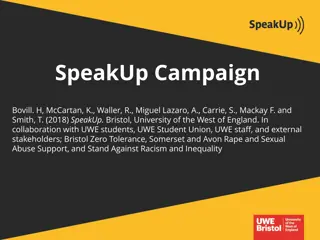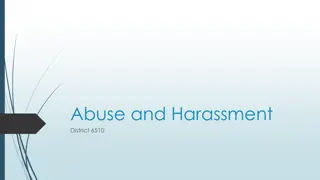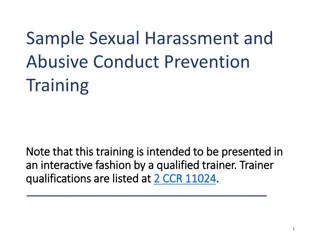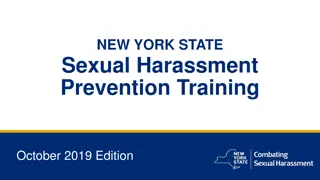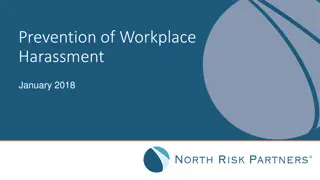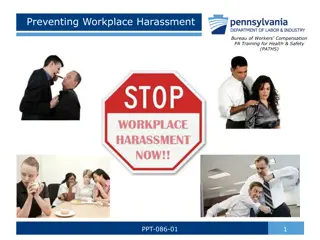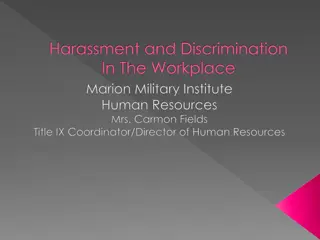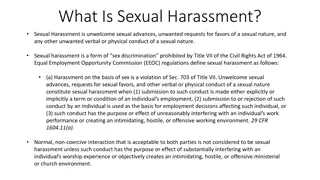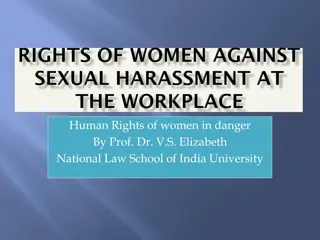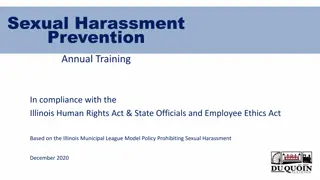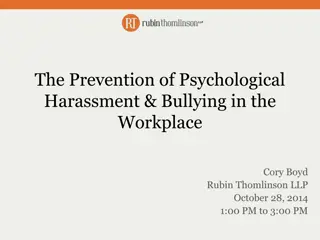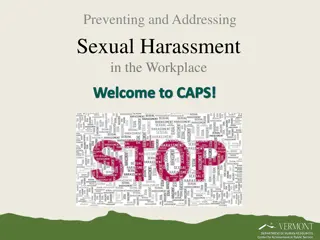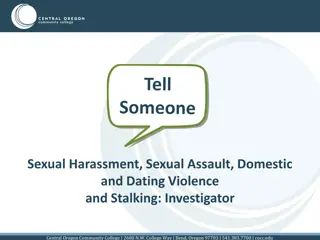Understanding Sexual Harassment in the Workplace
Sexual harassment is a form of discrimination that is prohibited by laws such as Title VII of the Civil Rights Act of 1964. It includes any unwelcome sexual advances, requests for sexual favors, or other conduct of a sexual nature. An environment becomes hostile when the behavior is both viewed as abusive by the victim and severe or pervasive enough to create a hostile work environment. To address sexual harassment, individuals can assess factors like the nature of the behavior, its impact on witnesses, and the power dynamics involved. It is important to recognize and report instances of sexual harassment to ensure a safe and respectful workplace for all.
Download Presentation

Please find below an Image/Link to download the presentation.
The content on the website is provided AS IS for your information and personal use only. It may not be sold, licensed, or shared on other websites without obtaining consent from the author. Download presentation by click this link. If you encounter any issues during the download, it is possible that the publisher has removed the file from their server.
E N D
Presentation Transcript
Sexual Harassment: What to do if it happens to you March 21, 2018 Rachel Lutner, J.D, Director, Title IX Coordinator Mariah Butler Vogelgesang, J.D., SPHR, Associate Director
Harassment is a form of discrimination. Title VII of the Civil Rights Act of 1964. Title VII prohibits discrimination in employment based on a person s race, age, color, religion, national origin or sex. Claims are investigated by the Equal Employment Opportunity Commission (EEOC) and adjudicated by the federal courts. Sexual harassment is defined as: any sexual advances or requests for sexual favors or any conduct of a sexual nature when: Ohio Civil Rights Act: The Act makes it a civil rights violation for any employer (more than 4 employees), employee, agent of any employer, employment agency or labor organization to engage in discrimination or harassment Sexual harassment can occur between same sex or opposite sex parties, regardless of gender expression or identity. Only the employer (the business) can be liable for sexual harassment.
When does obnoxious conduct turn into illegal harassment? A hostile environment occurs when: (1) the victim believes the conduct is abusive; and (2) the conduct is severe or pervasive enough to create a work environment that a reasonable person would find hostile or abusive. No single factor establishes a hostile environment. Courts look at the totality of the circumstances. Relatively trivial, isolated incidents generally do not create a hostile work environment. 1. 2. Sexual harassment was not proven where (1) women were asked for a couple of dates by co-workers; and (2) an employee was subjected to occasional teasing, isolated crude jokes and sexually explicit remarks. Sexual harassment occurred when (1) women were touched on their breasts and butt; and (2) forced to endure repeated unwelcome sexual advances. It doesn t have to be illegal for you to complain about it!
To assess whether a hostile environment exists, look at these factors: Is this verbal or physical behavior of a sexual nature? Is the conduct offensive to the persons who witness it? Is the behavior being initiated by only one of the parties? Is one person the recipient of most of the conduct? Does the employee have to tolerate the conduct to keep his or her job or to fit in? Does the conduct make the working environment unpleasant? Is there actual touching? Were threats made or implied? If the answer to these questions is "yes," the conduct may be unlawful harassment.
Examples of sexual harassment Verbal referring to an adult as a girl, hunk, doll, babe or honey; making sexual comments about a person's body; using innuendo; turning work discussions to sexual topics; telling sexual jokes or stories; asking about sexual fantasies, preferences, or history; asking personal questions about social or sexual life; repeatedly asking out a person who is not interested; telling lies or spreading rumors about a person's sex life. Non-Verbal: looking a person up and down (elevator eyes); staring at someone; blocking a person's path; following the person; giving personal gifts; displaying sexually suggestive visuals; making facial expressions such as winking, throwing kisses, or licking lips; making sexual gestures with hands or through body movements.
Examples of sexual harassment Physical pulling a woman s bra strap; grabbing someone s hand; giving a massage around the neck or shoulders; touching the person's clothing, hair or body; hanging around a person; hugging, kissing, patting or stroking; touching or rubbing oneself sexually around another person; brushing up against a person; standing in a person s personal space.
Welcome or unwelcome conduct? Only unwelcome conduct is unlawful harassment. Consensual dating, joking and touching, and teasing, for example, are not harassment if the behavior is not unwelcome or offensive to the persons on the receiving end of the conduct or the persons witnessing it. Some sexual advances ("come here babe and give me some of that") or comments ( I want fuck you ) are so crude and blatant that the conduct itself shows its unwelcomeness. Some indications that behavior is unwelcome: Outright rejection Ambiguous rejection Soured or past romance Mixed signals
You should clearly show that the conduct is unwelcome Use strong body language. Look the harasser in the eyes; speak in a strong, clear voice. Show assertiveness and strength through your voice, facial expressions, and body language. Project confidence and calm. Even if you do not feel that way, it is important to appear calm, serious, and confident. Do not apologize, make an excuse, or ask a question. You do not need to say sorry for how you feel or what you want. Be firm. Do not respond to diversions, questions, threats, blaming, or guilt- tripping. Stay on your own agenda. Stick to your point. Repeat your statement or leave. Decide when you re done. Success is how you define it. If you said what you needed to say and you re ready to leave, do so.
Ten things to say to stop a harasser Name the behavior and state that it is wrong Do not whistle at me, that is harassment, or Do not touch my butt, that is sexual harassment. Say exactly what you want move away from me, stop touching me, or go stand over there. Make an all-purpose anti-harassment statement, such as: Stop harassing people. I don t like it. Turn what they say or do around into a joke or make a clever statement in response. Congratulations, is that the first time you ve ever touched a woman? Use an A-B-C statement (and be very concrete about A and C): When you make kissing noises at me it makes me feel uncomfortable. I want you to say, Hello, ma am, from now on if you want to talk to me. Identify the perpetrator: Man in the yellow shirt, stop touching me. Attack the behavior, not the person. You are standing too close to me rather than blaming them as a person ( You are such a jerk ). Ask a Socratic question such as, That s so interesting can you explain why you think you can put your hand on my leg? Get a notebook and write in bold letters on the cover Sexual Harassment. Take out the notebook when you are harassed.
Retaliation is Prohibited No one can be retaliated against for complaining about sexual harassment. You are also protected from retaliation if you participate in an investigation, proceeding, or hearing on behalf of a someone else. Practically speaking, this is more complex.
Tips for dealing with harassment There is no one best thing to do, because every situation is different. Object to the conduct. There is no sexual harassment unless the conduct is "unwelcome." Make sure the harasser knows you don t like the conduct. Practically speaking, direct communication, whether verbal or in writing, is better than ignoring the behavior and hoping it will go away.
Tips for dealing with harassment: Report the harassment An employer or school does not need to address harassment that hasn t been reported or which the employer doesn t know about or shouldn t know about. Even a small employer or school without an anti-harassment policy is still required by law to protect students or employees from sexual harassment. Report to a supervisor, HR or some other department who has the power to stop the harassment. Report in writing and keep a copy. A written report helps communicate that you are serious. Describe the problem and how you want it fixed. If there is a policy employees or students are supposed to follow when reporting harassment, follow the policy to the fullest extent possible.
What if the harassment continues after it is reported? Find out if your complaint investigated. Return to the person or department to whom you previously complained and find out why your complaint was not investigated. Provide any new information about further harassment. Make it clear that you expect the company to investigate your complaint. If the prior complaint was investigated, but nothing was done, find out why. Lack of proof? Perhaps action was taken but you weren t informed. If you are still being harassed, you should let your employer know that the action taken was not effective to prevent the harassment from happening again, and further action is needed.
Investigation of harassment complaints. What can you expect? The investigators will be identified. A confidential investigation file is created. The investigator gathers facts and reviews policies. The victim and perpetrator are interviewed. The witnesses are interviewed and documents are reviewed. The complaint is taken seriously. Credibility is assessed. Confidentiality is required from all witnesses. The investigator evaluates facts from the perspective of a reasonable person with the victim s characteristics, and one with the alleged harasser s characteristics. Distinguish between "unwelcome" and "welcome" conduct. Draft a thorough, even-handed report. Identify and take effective corrective action There is follow up about the outcome with the victim.
Confidentiality What can you expect? Your complaint won t be kept confidential, but it will be kept as confidential as possible. Employers and schools will protect the confidentiality of harassment allegations to the extent possible. No one can guarantee complete confidentiality, since it may be impossible to conduct an effective investigation without revealing certain information to the alleged harasser and potential witnesses.
Awkwardness. Will I have to deal with that? After the complaint, you may still have to work with the harasser or victim. This may be uncomfortable. Work to get past it, and report if the harassment starts up again or you believe you are experiencing retaliation.
Questions? Questions? Questions? Questions? Questions? Questions?





